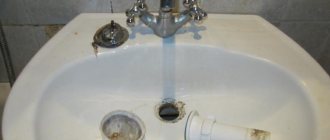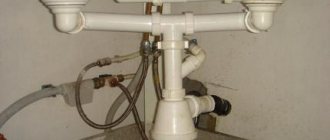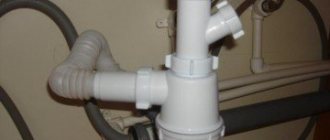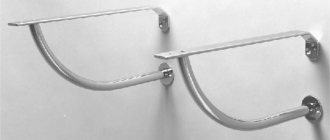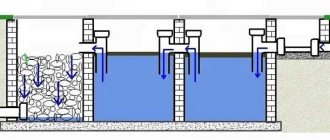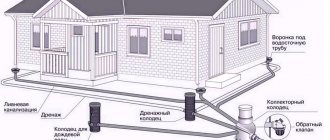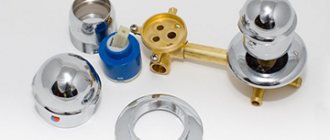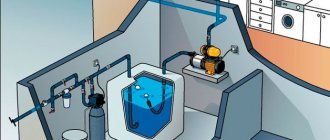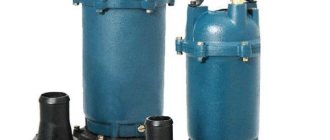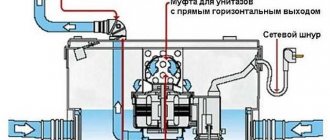- What is “overflow” and why is it needed?
- Types and differences of siphons
- Siphon straight, corrugated or with an elbow?
- Advantages of plastic siphons with overflow
- Sinks and siphons
- Manufacturers
Such a plumbing detail as a siphon is known to almost everyone. It firmly takes its place in every home and apartment, and there is simply nothing to replace it. A siphon is a hydraulic valve. In plumbing terms, this product is a water valve that prevents sewer gases from escaping into the room through a hole in the sink or through the toilet. In the modern world, all products that perform drainage are considered to be a siphon, but this is not entirely true. The sink siphon with overflow is especially famous.
Purpose of drain devices
There are several important tasks that a siphon for an overflow sink can successfully cope with:
- Drain wastewater from a kitchen or bathroom sink into a drainage system. This function is performed by pipes made of plastic or metal, depending on the type of siphon. The features of their device help remove grease and other debris into the sewer without delays and the formation of deposits on the internal cavity of the pipes.
- The protective mesh located in the neck of the device helps protect the drainage system from clogging with food waste and household debris. Moreover, this element is removable, which allows you to remove accumulated waste without resorting to disassembling the siphon itself.
- Creating a water seal. This function is assigned specifically to the siphon itself. The difference in the height of the water level in it and the height of the outlet tube contributes to the creation of a water seal. This trick helps prevent unpleasant sewer odors and gases from entering the apartment.
- Protecting the room from flooding if the main drain hole is blocked using an overflow system.
Manufacturers and prices
A siphon with overflow can be purchased at any store that sells plumbing fixtures. A wide selection of products allows you to purchase a product that is ideal for your sink. The most popular manufacturers include:
- EMMEVI – 1500 rubles;
- KLUDI – 1370 rubles;
- HANSGROHE – 1700 rubles;
- POTATO – 1300 rubles;
- KFA ARMATURA – 1850 rubles;
- VIEGA – 2000 rubles.
When installing a bathtub, sink, or washing machine, it is impossible to do without a product such as a siphon with overflow. Thanks to it, it is possible to eliminate the ingress of malodorous microorganisms and install plumbing fixtures quickly and easily. In addition, the cost of such a part is low, which will allow everyone to purchase it. We also recommend that you read the article, which will tell you what is the best material to make a bathroom ceiling from.
Overflow of water
There are several reasons why water from the sink begins to overflow:
- The drain hole is closed intentionally to fill the sink with water; the tap opens, but for some reason does not close again.
- Accidental blockage or blockage of the drain hole.
USEFUL INFORMATION: How to create a rustic-style interior with your own hands?
In such a situation, the sink drain-overflow system comes into play. Having reached a certain level, the liquid begins to flow out through a special technical hole, and through it, through the drain tube, it enters directly into the siphon reservoir and continues its path, as expected, into the bowels of the sewer system.
How to install it yourself
The installation of the siphon begins with its assembly.
Initially, install all gaskets in their places. Then start assembling the structure. The flask is put on, the outlet pipe is screwed on, initially putting a threaded nut on it, and screwed to the flask. Next, the corrugated tube is attached to the middle hole of the siphon.
Installing the assembled siphon on the sink is not difficult. To do this, you need to put a gasket on the outlet of the siphon, and place the outlet grill on top of the sink, which comes complete with the siphon.
Expert opinion
Romanova Ksenia Petrovna
Interior design expert and fabric store manager
If your sink is equipped with its own outlet structure, then we use it. An overflow drainage system is connected to the outlet pipe on the side surface of the sink.
They are connected from different sides of the sink with a special screw. The corrugated pipe is connected to the sewer.
Now you need to turn on the water and check all connections for leaks.
- Once a week it is necessary to flush the drain with 4 liters of hot water, but not boiling water. This procedure will wash away all accumulated fat and rid the kitchen of unpleasant odors.
- Install an additional mesh over the outlet of the sink. It will prevent large debris from entering the drain, thereby preventing the sewer pipe from clogging. You can install an electric disposer that will grind the waste that ends up in the drain.
- Clean the siphon flask once a month.
- Sudden changes in water temperature can damage the plastic and connecting gaskets, so you should not suddenly throw boiling water into the sink after cold water.
- Do not wash greasy dishes with cold water, even if the hot water has been turned off; heat it in a kettle.
- Modern cleaning products, especially those containing chlorine and acid, have a harmful effect on both plastic and rubber gaskets, so their use should be limited. Vinegar, lemon, soda will help clean the siphon and return it to its original condition.
Of course, you can install any siphon on the sink, but if it is additionally equipped with an overflow protection for the sink, this will provide additional protection for your kitchen from flooding.
The appearance of this attribute of the drainage system, of course, plays a role, especially if the siphon is not hidden from view, but still the technical characteristics here should come to the fore. Therefore, before purchasing, you should consult with a specialist. Then it will last a long time and will not cause you any inconvenience.
Varieties
A siphon for a sink with an overflow can have two design options, according to which it can be classified as one of the following types of devices:
- Bottle type. The most popular siphon for the kitchen sink. It owes its name to a rigid container that looks like a bottle, located between the drain hole and the outlet pipe, inside which a water seal is formed. The housing is easy to disassemble and the height can be adjusted.
- Pipe. It looks like a pipe bent in the shape of the letter “S”. The formation of a water seal is ensured precisely due to this bending.
Both types of devices may have additional connections for connecting a washing machine or dishwasher.
Classification
By design features
The design differences of siphons force specialists to divide products into types. Let's take a closer look at popular kitchen devices.
- Bottle. Its rigid container, which is inserted between the outlet pipe and the drain outlet, really resembles a bottle. The height of the device is adjustable. The standard installation location is under the kitchen sink. In addition to the bottle flask, the design includes a drain hole, an outlet pipe, an overflow hose, washers, gaskets, and nuts. The flask can contain many input drains that are needed for other household appliances.
- Pipe. This siphon is often installed at the bottom of the shower stall. The item is convenient in the bathroom as it does not take up much space. The design of the device includes a drain hole, an overflow tube, a curved connection, a set of nuts and gaskets.
- Corrugated. This siphon is a simple device in the form of a corrugated tube. To form a bend, it is simply folded and fixed. This part subsequently plays the role of a water seal. In addition, the design includes a drain hole, overflow and connecting parts.
- Flat. This siphon has a conventional design. It is needed when other devices cannot be selected according to their dimensions.
- Hidden. Such a device is placed in a niche, out of sight. The device is mounted on the wall, suitable for sinks and washing machines.
According to manufacturing materials
Plastic siphons are made of PVC or polypropylene. The second option is the most popular because it is inexpensive and easier to use.
The advantages of the material are the absence of corrosion and rotting from prolonged exposure to water. Polypropylene has high throughput.
Dirt does not accumulate inside the walls of such products.
Brass, copper and bronze models are more expensive, but of high quality. Although such products oxidize without a special coating, they never rust. A common place for installing such devices is the bathroom.
Stainless steel appliances are rarely used, as they are very expensive. Usually they are needed to create certain stylistic solutions. The devices have an excellent appearance.
Products with an outer coating made of decorative, for example, chrome-plated alloys also look good. They are great for creating a stylish interior. However, the cost of such products is impressive.
Specifics of choice
One of the main parameters that you should pay attention to when choosing a siphon is the material it is made of. The store will offer you two varieties:
- Metal (cast iron, bronze, brass, steel). They are more difficult to install than plastic ones, and besides, the concept of flexibility inherent in corrugated pipes is not characteristic of them.
- Plastic. An economical option, not subject to corrosion, but at the same time, if chosen correctly, it is quite durable and easy to install/dismantle.
To make the right choice, determine in advance the installation location of this device. Will it be installed on the sink and hidden in a kitchen cabinet or in the leg of a “tulip” washbasin, or be left in the open? When choosing the first location option, it makes sense to choose a plastic option, but if the siphon is located in plain sight, you should think about more decorative metal models.
USEFUL INFORMATION: Types of kitchen hoods: what are they and how to choose?
If there is an additional drain hole in the sink, before purchasing a siphon, check its configuration, because you need an additional tube for the drain-overflow system. By installing the most ordinary siphon on such a sink, you can become an unwitting culprit of flooding not only your own, but also your neighbor’s home.
It also doesn’t hurt to pay attention to the capacity of the siphon; if it is insufficient, this can cause a flood, and overflowing will not help in this case.
Sinks and siphons
The use of overflow in siphons began several centuries ago, and it is obvious that this development has taken root. Now all manufacturers create sinks with an overflow hole, as demand creates supply. By the way, there are a great variety of materials for making sinks.
In the modern plumbing market, you may encounter difficulties in choosing a sink; there is a huge variety of them. As for the siphon, its choice cannot be called difficult. You need to choose only one type out of three and not “miss” the choice of manufacturer.
In Russia, several manufacturers are engaged in the production of hydraulic valves and other plumbing elements. It is worth saying that domestic plumbing is not inferior to European, but is more affordable in terms of price.
Siphons are mostly created from plastic, but it is also possible to create a unique product from copper and tin. They are produced in single quantities, since the demand for them is not high. They do not differ in functionality from their plastic counterparts, but, of course, they look much more solid.
A copper siphon is a striking product, but you should be wary of streaks and darkening caused by time and moisture. This product must be properly cared for.
Standard equipment for siphons with overflow
For subsequent self-assembly of the drain system, we recommend that you understand its composition, which includes:
- The top part of the system, called the release. It consists of a metal mesh, a bolt securing it and a base.
- Exhaust pipe (neck). Can be equipped with additional branches for installing a washing machine or dishwasher.
- A hose or rigid pipe for drainage and overflow.
- Siphon body.
- Outlet pipe connecting the siphon and the sewer system.
- Consumables (seals, bolts, etc.).
The parts should be connected to each other only using seals, otherwise leaks may occur.
Bowls without drain-overflow system
If you are purchasing a standard sink without accessories, a siphon will not be so difficult to purchase. If you choose a designer model, it is advisable to purchase a siphon included.
In the photo: siphon A750114CR from Daniel Rubinetterie.
Bowls on the tabletop.
The design of the bowl may be hampered by an extra hole, or due to its unique shape there is nowhere to mount a drain channel, and not all sinks can be equipped with a built-in system. Most often, there is no “drain-overflow” in bowls that are placed on the countertop, visible from all sides, or, for example, in sinks made of colored glass or natural stone.
Alternative.
Such bowls will necessarily (this is the norm for manufacturers) be equipped with a regular drain, which cannot be blocked - although it has a “cap”, its function is only decorative. When choosing fittings for such a drain, take into account the minimum and maximum thickness of the entire structure (sink, countertops in the place where the drain is installed).
- 1 of 4
On the picture:
What to look for when choosing
When connecting a plumbing fixture to the sewerage system, make sure in advance that the siphon connected to it meets all the parameters of this fixture.
Pay attention to the following points:
- Siphon dimensions . Bottle type devices are the largest. Therefore, if you have a lot of space under the sink, then feel free to buy such a device. However, there are other situations. If your washing machine is located under the sink, then there is no or minimal space for installing a conventional siphon. Therefore, purchase a flat siphon for the sink above the washing machine, which is very compact in size. In addition, it is located in a horizontal plane, allowing the machine to take up all the free space under the sink;
- Ease of maintenance . Most often, siphons in the kitchen become clogged, as they allow food debris to pass through them. And bottle siphons are the most convenient and fastest to clean, so prefer this type for a kitchen sink;
- Consider the diameter of the neck of the plumbing fixture. The fact is that the sink and washbasin may differ in these indicators. The bathroom sink siphon may not fit the kitchen sink;
- If it is connected to the siphon drain from other appliances, then make sure that there are one or two inlet fittings in the siphon body;
Siphon with additional outlet for washing machine - The outlet of a cheap siphon can be a regular grille, while for expensive models the outlets can be made in the form of adjustable valves, often of the push type;
- Presence of overflow . It is advisable to purchase a product with an overflow. This will increase the safety of using plumbing fixtures;
- The diameter of the outlet pipe that connects to the sewer pipe. A siphon for a washbasin, bathtub or sink is equipped with a tube with a pipe, the diameter of which must correspond to the diameter of the sewer pipe or be smaller. In the latter case, an adapter is used. You will not be able to connect a larger diameter pipe to the drain.
Tip: The price of the siphon is also important, but it is not decisive when choosing. Even inexpensive plastic products work quite well and last a long time with proper care. Therefore, choose products that will not impact your budget.
Do you know how to install a water filter under a sink? You can do this yourself and save on calling professionals.
If you need to repair a bathroom faucet with a shower, also do not rush to call plumbers, first read our article.
There is useful information on choosing radiators here. Comparison of different options.
Purpose and design features
The drain-overflow is necessary so that the sink does not overflow with liquid, and the excess goes into the drain. Similar devices are used for metal or ceramic sinks. The devices practically repeat the design of a bath siphon.
The overflow in a sink is a hole in its upper part. When the owner does not close the tap, the liquid drains through this hole. A tube is connected to the overflow, through which the liquid flows. Most often the hole is made under the tap, but there are models in which it is located under the sink.
Siphon for the kitchen.
The washbasin waste and overflow includes 2 main parts:
- Curved siphon (like the Latin letter U). Its bend creates a water seal, which prevents unpleasant odors from spreading throughout the room.
- A drain pipe. It is a piece of rigid plastic construction or a section of corrugated pipe. The task is to redirect wastewater into the sewer system.
Thanks to the bending, the liquid does not leave the structure completely. If clogged, the sink siphon can be easily removed and cleaned using mechanical and chemical methods.
In addition to the classic models, there are overflows with an additional tube. It is needed so that you can connect the overflow hole with those structural parts that are located in front of the sink. There are models with a bottom valve, but they also operate on the principle of communicating vessels.
A grate is installed on the outside of the drain. It provides protection against clogs as it traps even hairs and smaller particles of debris.
Main types of siphons
Siphons for washbasins are classified according to the principle of their design. Having looked at the design in cross-section, the specialist will understand which one is better suited in a particular case. In addition, siphons are made of different materials, which determines their strength and durability.
Classification by device principle
There are 3 main types of siphons (although models from different manufacturers may differ in details). These include:
- Bottled. They are called flask-shaped because they include such a component in their design. In such systems, water enters the siphon, but moves inside through a separate pipe of smaller cross-section. When it reaches the bottom, the wastewater penetrates the cavity between the 2 cylinders and is then discharged into the sewer. Bottle systems are especially good for country houses, because they do not dry out even after prolonged inactivity. In addition, several drains are connected here at the same time.
- Pipe. Classic version, equipped with a pipe with a U/S bend.
- Mixed option. Includes bottle element and corrugated hose.
Pipe and mixed systems have proven themselves well in practice, especially in urban environments.
Division by material of manufacture
There are only 2 types of materials that are used to make siphons - plastic and metal, since they correspond to the purpose of the equipment and the conditions of its operation.
Plastic (or polymer) siphons are characterized by their low price and availability. In addition, their installation is so simple that you can easily do it yourself. Mold does not appear on the surface of such products, especially since manufacturers include antibacterial components in the composition. If we are talking about models equipped with a corrugated pipe, then one of the advantages is the ease of length adjustment.
But plastic sink siphons have disadvantages:
- short service life;
- When using them, it is impossible to achieve good sealing and you have to additionally use rubber gaskets.
Metal sink siphons also have advantages:
- strength;
- reliability;
- long service life;
- attractive appearance, since such structures are often made of brass and chrome-plated;
- protection from dirt deposits on the inside;
- ease of installation.
But metal siphons also have disadvantages:
- higher cost compared to plastic structures;
- Dirt deposits can build up on the inner walls, increasing the risk of clogging.
For non-standard equipment
In equipment manufactured for double sinks, siphons are needed with 2 outlets. They are connected simultaneously to the drains of both sinks. And then, at the required distance from the drain, they are again combined into 1 flask. Such models come in pipe or bottle versions.
Non-standard models include siphons for sinks installed on an open shelf. They are more expensive, but it is important to make sure that the unsightly plumbing fixture is invisible. Therefore, either choose an attractive brass element, or practice hidden installation, hiding the equipment behind a decorative screen or niche.
